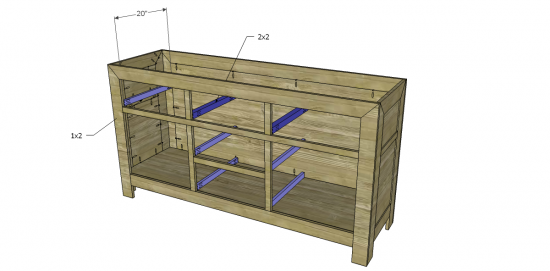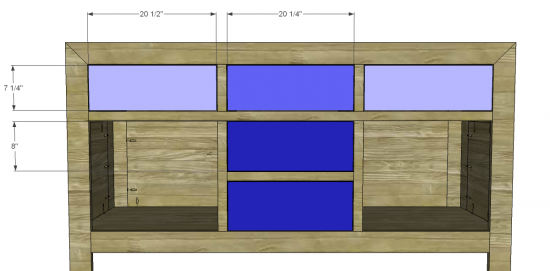
Free DIY Furniture Plans to Build Pottery Barn Inspired Large Dawson Media Console. LOVE this collection, that’s all I have to say… Xx… Rayan
As with all of our plans, you are building at your own risk and you should have a firm understanding of building in general before you attempt many of our plans (some are easy as pie and perfect for beginners). With that, go forth, have fun, take lots of pictures and share them in a showcase on the site or on social media with the hashtag #builtTDCtuff and we will share our faves! Be sure to tag @thedesignconfidential on Instagram / FB and @thedesconf on Twitter / Pinterest. If you are a blogger and you post about your build, don’t forget to include a link to your post on your showcase here. Don’t forget… for all of our newer plans, clicking on the images will let them expand to enormous sizes with much greater clarity. The older plans may need updating so please let us know if you need one fixed!
$150-$200
- Tape Measure
- Saw – Jig Saw, Circular, Table, or Miter Saw
- Drill
- Multi-Square and Carpenter’s Square
- Sander
- Kreg Jig – if you build frequently, invest in this one.
- Nail Gun
- 4 – 1×2 at 8’
- 7 – 1×4 at 8’
- 1 – 2×2 at 2’
- One sheet of ½” plywood
- One sheet of ¾” plywood
- One half sheet of ¾” plywood
- 1″ Pocket Hole Screws
- 1-1/4″ Pocket Hole Screws
- 1-1/2” Wood Screws
- 5 sets of 18” drawer slides
- Drawer & Door Pulls
- Two sets – Face Frame Concealed Hinges
- Concealed Hinge Jig
- Anti-Tip Kit
- Countersink Drill Bit
- Pocket Hole Plugs – Paint Grade, Pine, Oak – optional
- Clamps
- Safety Gear
- 3/4″ Edge Banding – optional
- Wood Filler
- Wood Glue
- Sanding Supplies
- Paste Wax
- Finishing Supplies
- 8 – 1×4 at 38” – Side, Front, & Back Frames
- 2 – 1×4 at 20” – Side Frames
- 2 – 1×4 at 13” – Side Frames
- 2 – 1×2 at 13” – Side Frames
- 2 – ½” plywood at 8” x 13” – Side Panels
- 2 – ½” plywood at 13” x 17-1/2” – Side Panels
- 2 – 1×4 at 72” – Front & Back Frames
- 2 – 1×4 at 65” – Front & Back Frames
- 1 – ½” plywood at 27” x 65” – Back Panel
- 1 – ¾” plywood at 20” x 70-1/2” – Bottom
- 1 – 1×2 at 65” – Front Frame
- 2 – 1×2 at 7-1/2” – Front Frame
- 2 – 1×2 at 18” – Front Frame
- 1 – 1×2 at 20-1/2” – Front Frame
- 8 – 1×2 at 20” – Side Slide & Top Supports
- 2 – 2×2 at 20” – Slide Supports
- 2 – ¾” plywood at 20” x 23-1/2” – Tops
- 1 – ¾” plywood at 20” x 20-1/2” – Top Center
- 2 – ¾” plywood at 17-1/4” x 18-1/4” – Drawer Bottoms
- 10 – ¾” plywood at 5-1/2” x 17-1/4” – Drawer Sides
- 2 – ¾” plywood at 5-1/2” x 19-3/4” – Drawer Backs
- 2 – ¾” plywood at 7-1/4” x 20-1/2” – Drawer Fronts
- 3 – ¾” plywood at 17-1/4” x 18” – Center & Lower Drawer Bottoms
- 1 – ¾” plywood at 5-1/2” x 19-1/2” – Center Drawer Back
- 1 – ¾” plywood at 7-1/4” x 20-1/4” – Center Drawer Front
- 2 – ¾” plywood at 8” x 19-1/2” – Lower Drawer Backs
- 2 – ¾” plywood at 8” x 20-1/4” – Lower Drawer Fronts
- 2 – ¾” plywood at 17-3/4” x 20-1/2” – Doors
Before beginning to build, always check in on my site to make sure you have the most up to date set of plans, I occasionally update and change the plans to make the building process easier or to allow for less expensive purchasing of materials! Read through the entire set of instructions and all comments before beginning this project. If you print out or save plans, be sure to check in on my site to be sure you have the most up to date set of plans, as I occasionally update things for ease of building or buying. If you are new to building, read through the GETTING STARTED section and other articles found under the BUILD tab in the menu on my site, it has valuable information about how to get started, tools and techniques. If you are unfamiliar with the finishing process, visit my Finishing school for some tips and tricks for painting like a pro and for special finishing practices. Use glue to secure your joints and Consider Painting or Staining individual sections prior to assembling. This makes the paint application virtually flawless. Coat with a spray on Poly or Wipe on Poly to protect your finish and your piece and it will last for ages. Adhere to all safety standards and guidelines, and be sure you follow safety protocol throughout your build. If you are unsure about whether you are building safely, run a quick online search for the tool or technique you are using, or contact me via email or post to the forum before you move ahead. My contact info can be found in the menu of my site.
Cut the pieces for the side frames. Cut a 45 degree miter at the top of each of the legs, as well as each end of the side top pieces. Set the Kreg jig for ¾” material and drill pocket holes in each end of the top frame piece, the center frame piece, and the lower frame piece. Also, drill pocket holes in the outer edges of the legs to attach the front and back frames.
Cut the pieces for the side panels. Set the Kreg jig for ½” material and drill pocket holes as shown. Attach the side panel pieces to the horizontal pieces using glue and 1” pocket hole screws. Attach the entire assembly to the legs using glue and 1” pocket holes through the side panels into the legs, and 1-1/4” pocket hole screws through the top frame pieces.
Cut the pieces for the front frame. Drill pocket holes and assemble the frame as shown using glue and 1-1/4” pocket hole screws.
Attach the frame to the front using glue and 1-1/4” pocket hole screws through the side frames and bottom.
Cut the piece for the bottom. Set the Kreg jig for ¾” material and drill pocket holes in each end as well as the front and back edges. Attach to the sides and back as shown using glue and 1-1/4” pocket hole screws. The top of the bottom piece should be flush with the top of the lower frame pieces at the sides and back.
Cut the pieces for the back frame. Cut a 45 degree miter at the top of each of the legs, as well as each end of the side top pieces. Set the Kreg jig for ¾” material and drill pocket holes in each end of the top frame piece and the lower frame piece.
Cut the pieces for the back panel. Set the Kreg jig for ½” material and drill pocket holes as shown. Attach the back panel piece to the top and bottom pieces using glue and 1” pocket hole screws. Attach the entire assembly to the legs using glue and 1” pocket holes through the side panels into the legs, and 1-1/4” pocket hole screws through the top frame pieces.
Cut the pieces for the slide supports. Drill pocket holes in each end of the 1×2 pieces. Attach to the sides of the cabinet using glue and 1-1/4” pocket hole screws. The bottom of the supports will be flush with the top of the stretcher piece of the front frame as well as flush with the inside edge of the front frame.
Set the Kreg jig for 1-1/2” material and drill pocket holes in each end of the 2×2 slide support. Attach to the front frame divider using glue and 1-1/2” pocket hole screws and to the back using 1-1/4” pocket hole screws. The bottom of the slide support will be flush with the top of the stretcher piece of the front frame.
Cut the piece for the top support. Set the Kreg jig for ¾” material and drill pocket holes in each end. Attach as shown using glue and 1-1/4” pocket hole screws.
Cut the pieces for the top. Drill pocket holes around all four edges. Attach using glue and 1-1/4” pocket hole screws from the underside. The top face will be flush with the top edge of the front, back, and side frames.
Cut the pieces for the drawer boxes. Drill pocket holes in all four edges of the bottom pieces as well as each end of the side pieces. Attach the sides to the bottom using glue and 1-1/4” pocket hole screws. Attach the front and back as shown. The drawer front will overlap the sides by 3/8”. Install the drawer slides according to the manufacturer’s instructions. For an easy tutorial, click here. Make any necessary adjustments. There will be a 1/8” gap around all sides of the drawer fronts. Install the cabinet hardware.
Cut the pieces for the doors. There will be a 1/8” gap around all sides of the doors as well as in the center. Install the hinges and the cabinet hardware.
Fill any Screw, Nail or Pocket Holes, Sand and Finish as Desired. For Finishing Tips and Tricks visit my Finishing School
**Disclaimer: Some rights reserved. Private use only. Feel Free to link to any of my plans so long as you provide an adequate link back to the appropriate post! Plans from this page are not to be used for commercial purposes or republished without the express written consent of Rayan Turner, The Design Confidential I hope to provide accurate plans, however, I cannot guarantee each plan for accuracy. Not every plan that I post has been built and tested, so you are building at your own risk. It is recommended that you have a clear understanding of how the project works before beginning any project. Please contact me if you find an error or inaccuracy so that I might fix it.
















